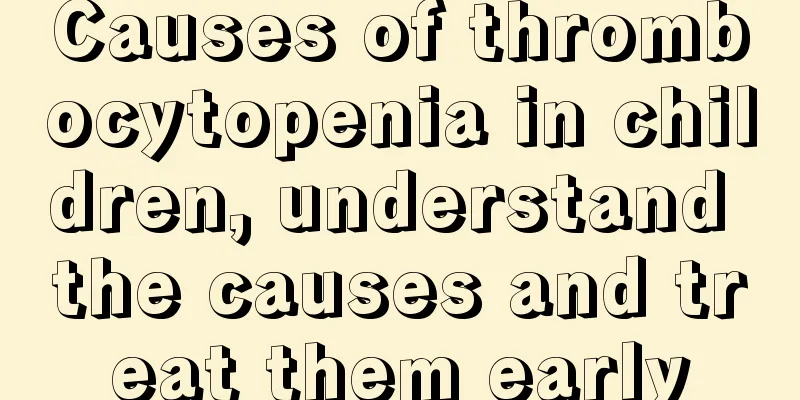Causes of thrombocytopenia in children, understand the causes and treat them early

|
Thrombocytopenia is very harmful to children and can cause anemia. Many children with thrombocytopenia will also experience bleeding gums, fever, and general fatigue. Thrombocytopenia has both genetic and acquired factors and should be treated as soon as possible. Causes of thrombocytopenia 1. Death due to decreased or ineffective platelet production: both hereditary and acquired. Acquired thrombocytopenia is caused by certain factors such as drugs, malignant tumors, infection, ionizing radiation, etc. that damage hematopoietic stem cells or affect their proliferation in the bone marrow. These factors can affect multiple hematopoietic cell systems, often accompanied by varying degrees of anemia, leukopenia, and a significant decrease in bone marrow megakaryocytes. 2. Excessive platelet destruction: both congenital and acquired. Acquired platelet destruction includes immune and non-immune causes. Common immune causes of excessive platelet destruction include idiopathic thrombocytopenic purpura and drug-induced thrombocytopenia. Excessive destruction of non-immune thrombocytopenia includes infection, disseminated intravascular coagulation, thrombotic thrombocytopenic purpura, etc. 3. Excessive retention of platelets in the spleen: most commonly seen in hypersplenism. Splenectomy is one of the treatments for thrombocytopenia. Symptoms of thrombocytopenia 1. Clinically, the appearance of anemia symptoms is an important manifestation of thrombocytopenia. However, due to different pathogenic factors of patients, the anemia conditions of patients are also different, which are generally divided into acute and subacute types. Acute mainly refers to diseases such as leukemia, aplastic anemia and acute intravascular hemolysis; subacute mainly refers to common diseases such as acute aplastic anemia, cellular anemia and autoimmune anemia. 2. When suffering from thrombocytopenia, patients will often experience bleeding symptoms. This symptom mainly occurs on the surface of the patient's skin. Generally, large bruises can be clearly seen. In addition, some patients may also experience bleeding symptoms in the gums, nose, mouth, etc. In severe cases, the patient's digestive tract and internal organs may also experience bleeding symptoms. 3. Fever and pale face are also symptoms of thrombocytopenia. This is mainly due to the gradual decline in the patient's resistance, making them susceptible to infection. Clinically, patients often experience symptoms such as fever, pale complexion, and general fatigue. In severe cases, patients may also experience symptoms such as digestive tract infection and urinary tract infection. |
<<: What should I do if my child doesn't like to eat?
>>: How to treat bedwetting in children? These methods solve the problem
Recommend
What are the treatments for vitiligo in children?
Many patients with vitiligo in children are affec...
What are the symptoms of cerebral palsy in babies?
Because people nowadays only have physical examin...
What are the causes of milk allergy in babies?
When the baby is young and cannot eat complementa...
How to treat children with fever and oral ulcers
When children catch a cold, they will have a feve...
Examination of infantile megacolon
Some people always don’t understand how a newborn...
How to improve children's cold and cough
Cold is a very common disease. Medicine is the be...
What should children eat to grow taller?
The living standards are very good now, and every...
What to feed your children to make them grow taller
Whether every child can develop normally is a mat...
What fruits can help babies grow taller?
What fruits can help you grow taller? Pear, pear ...
The reason why baby's yellow-green stools are formed
Many parents have some misunderstandings when fee...
Symptoms of heavy dampness in children
We often say that a person has a lot of dampness ...
What causes a child to have a seizure while sleeping?
Sometimes children yawn inadvertently, frown, or ...
What causes bad breath in a three-year-old child?
Bad breath is a very common phenomenon in life. G...
What is the reason for the doll's nose bleeding?
The nose is a relatively fragile organ of the hum...
Why does my child’s genitals itch?
Don’t think that only adults will suffer from gen...









